Will the area under a voltage vs. time graph of a battery discharge curve (with a constant current load) give the amp-hour capacity rating of the battery?
3 Answers
It's not the area under the curve but the partially discharged (final) level of the voltage that is important thing. The area gives you volt-hours and not ampere hours.
A manufacturer uses a constant current load and whilever the battery is able to produce above a "certain" minimum terminal voltage the hours that count the amps will keep ticking.
This, however does not mean that it will suit a specific target design. Here is an example of a discharge curve for a lightweight PP3 9V battery: -
Note that they define the end voltage and this means "end of test" because to drag more enrgy from the battery is going to either make it unsafe, unusable in 90% of target applications and render it impossible to recharge (if it were a rechargeable type). You have to set an end limit that is meaningful or you'd be conning the public.
Look at this AA battery: -
After just over 2 (and a bit) hours of 100mA discharge it's not a 1.5 volt battery any more. Another thing to watch out for is how they have used a constant current source - calculating ampere hour rating at 1mA gives you a better figure than at 100mA. Buyer beware and read the spec.
Take a look at the Duracell MN1500 battery and if you have any questions on this raise them. It should give you a good idea what a good supplier does to test their batteries.
- 434,556
- 28
- 351
- 777
-
Also worth noting that if you did want to measure the actual energy capacity of the battery, you could integrate the current vs. time plot. An ampere is defined as one coulomb of charge per second, so integrating that over a period of time gives you the total amount of charge that has gone in/out of the battery. From there you could get the total capacity of the battery in Joules. – alphasierra Dec 24 '15 at 21:54
-
@Andy aka You can make a voltage vs. time discharge curve by monitoring the battery voltage with a multimeter. Can I use a constant current load and monitor the amps (instead of voltage) with my multimeter, make a amps vs. time graph, and then take the area under the curve to find amp-hour capacity? – user5139637 Dec 24 '15 at 21:54
-
Sure, but it's even easier to feed into a fixed resistor. Divide each voltage reading by the resistance value and there's your current. Don't get too hung up on exact measurements. There are too many variables - temperature, discharge rate, initial charge, etc., to give any precision to the Ah rating. – Transistor Dec 24 '15 at 22:11
-
@user5139637 You can use a constant current load but how will you know when the voltage has dropped and reached its "kill-the-battery-point". Some batteries cannot be discharged until 0V because they'll burn or they'll never work again. – Andy aka Dec 24 '15 at 22:22
-
@Andy aka what is the solution to this problem because yes, I am having the same problem as you mentioned – user5139637 Dec 24 '15 at 22:25
-
@transistor then would I construct the y -axis of the graph using the I = V/R equation and plot it against time? Would the integral then give me amp-hour – user5139637 Dec 24 '15 at 22:27
-
Yes. Another advantage of using the voltage is that you can disconnect the load at some predetermined voltage to prevent running the battery too flat. 10 or 11 volts, for example, on a lead-acid battery. – Transistor Dec 24 '15 at 22:30
-
@user5139637 You don't need to monitor the current in the constant current load, because it is... constant. You set the current, and you don't need to monitor it. – Nick Alexeev Dec 24 '15 at 22:33
-
I've added to my answer @user5139637 – Andy aka Dec 24 '15 at 22:34
-
@Andyaka as transistor proposed, if I do not have a circuit for a constant current load, can I use a constant resistor, something like a 43 ohm resistor (as in the link you have provided) and measure the voltage over time. Then can I make a amp vs time graph using I = V/R and integrate that curve to find the amp-hour capacity – user5139637 Dec 24 '15 at 22:40
-
Yes you can do that but beware, you may not get what the manufacturer specified. BTW what are you trying to achieve? – Andy aka Dec 24 '15 at 23:11
No, in your case it is not the area that tells you the capacity, but the length of time before the voltage is so low that the battery is considered discharged. For example, if the battery started out a 4.0 V, then decreased over 1.9 hours to 2.7 V when you considered it empty, the capacity is 1.9 hours times the discharge current. If the discharge current was 1.3 A, for example, then the capacity was (1.9 h)(1.3 A) = 2.5 Ah.
The area under the graph is proportional to the total energy the battery delivered. Actually its merely the time integral of volts. But you said that the current was constant, so volts is proportional to power, and the time integral of power is energy.
- 310,974
- 36
- 428
- 915
-
1Thank you. And by the discharge current, you mean the constant current load that I will use? – user5139637 Dec 24 '15 at 22:11
-
Will the area under a voltage vs. time graph of a battery discharge curve (with a constant current load) give the amp-hour capacity rating of the battery
[emphasis mine, N.A.]?
No. Not even close. Even units of measurement would not match.
Here's how to get Ah rating for the battery from voltage vs. time chart. One needs one more piece of information: discharge current. It's usually written on the chart.
 (source)
(source)
Let's say that the cutoff voltage for the battery in this chart is 6V. Under this voltage, we consider that the battery is depleted. At 8A discharge current, it will take roughly 20 minutes to discharge the battery down to 6V level. 8A * 0.3h = 2.4Ah (notice that the supplier advertised 3Ah).
(By the way, here's a somewhat related thread with a different set of charts.)
- 37,739
- 17
- 97
- 230

